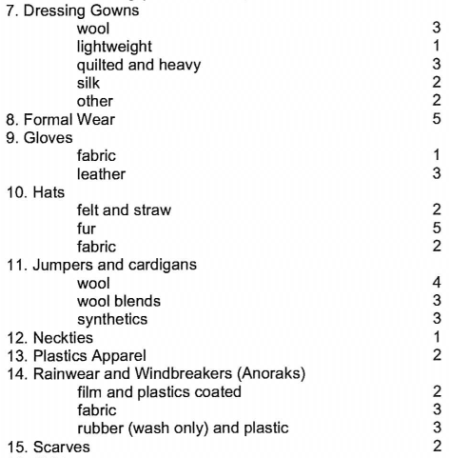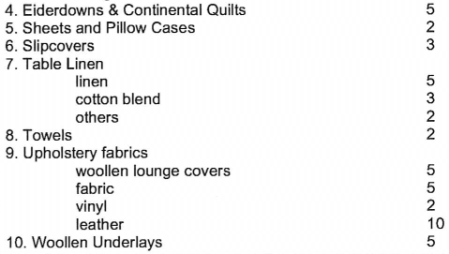Removing Cookout Stains
Removing Cookout Stains
Summertime is the cookout season, which means hamburgers, hotdogs, and plenty of potential stains. Not to worry, today’s tip will show you how to remove those pesky stains from your garments.
removing stains
Always remember, the process of removing a stain varies depending on the garments fabric and the stain type. Treatments that may work on cotton could damage or destroy silk, wool, Rayon, etc. Always read the care labels and never dry or iron a stained item. Bring garments to a professional cleaner if they say dry clean only or if the stain remains after treatment.
Removing Ketchup, Barbeque Sauce and Mustard Stains
React quickly.
Don’t give your stain time to set itself comfortably into the fabric of your clothes. The sooner a stain is treated the better the chance of removal.
Remove excess
Use a dull edge, like the back of a butter knife or the edge of a spoon, to remove the excess ketchup, mustard or BBQ sauce from your garment. Be careful not to damage the fabric and work from the outside in to prevent spreading the stain.
Flip it
Turn the garment inside out so when you treat the stain it is forced out of your clothing and not further into the fabric. Place a light-colored cloth under the stain to prevent it from spreading to the other side of your clothes.
The Solution
Mix together a solution of water and white/clear dish detergent, and then blot the stain to push it out of your garment. The dish detergent will help to break down the stain as well as dyes like turmeric, which give the mustard its yellow color.
Rinse and wash
Soak the garment in warm water, and then wash the item. Be sure not to dry or iron the garment until you are 100% sure the stain is out. If the stain persists get it to our professionals, we will be able to get the stain out without causing harm to the fabric of your clothes.
What Not to Do
Never treat non-washable items, always bring them to a professional. (Silks, wool, rayon, etc.)
To prevent spreading and protect fabrics always blot a stain. Rubbing will only spread the stain and possibly damage the fabric.
Do not use bleaching agents as these will damage most fabrics
Never use ammonia or cleaning products that contain ammonia on mustard, this can set the yellow dye into your garment.
Never dry or apply heat to a stained garment, this will set the stain.
The evolution of the dry cleaning solvent
By any time once a fancy dress, a formal garment of like an elegant design is messed up or in disarray some of those clothes that have to be made clean fine and likely hard to clean materials. While Fabrics as such a can be made clean in washing machines it is not recommended. For some people, they take on the arduous undertaking of washing some of these delicate brands. However, to preserve your garment, some select To clean these clothes to their local dry cleaner.
So, What is Dry Cleaning?
Dry Cleaning is called the ‘dry’ because it’s cleaning operation means that it picks an article of clothing and textiles without the normal method of using SOAP and H2o. Instead of using water, it uses different types of Dry cleaning fluid or Dry cleaning solvent to remove the dirt out of apparels, thus the term Dry Cleaning.
How did Dry Cleaning Solution come about?
In short, it all started out with Spilled coal oil in the mid-19the hundred, by Jean-Baptiste Jolly and his maidservant, on a piece of linen, thereafter the incident became a cleaner and thus Dry Cleaning solvent was keyed out. The use of kerosene and other explosive liquids gas, naphthea, became the new way used on fabrics and traces to get them cleaner and a Dry Cleaning solvent was conceived altogether by accident.
So, while the process of dry cleaning began to develop since from the 1920s thru the 1950s, these initial petroleum-based dry cleaning Solution } were extremely flammable. It took an on-site dry Cleaning company, owner William Joseph Stoddard to develop a less explosive dry cleaning solvent to dry clean clothes. His development ‘Perc’ was a boom particularly because it was nonflammable, not as foul-smelling , and the best dry cleaning solvent known for taking away soil.
After WWII, dry cleaning solvents were developed containing ethylene and tetrachloroethylene or ‘perc’ became a style of dry cleaning solvent. Perc, rapidly became a more Stable, incombustible and chlorinated Dry Cleaning Chemical substance with neat cleaning properties, and on the vestry, the most Despite being an ideal dry cleaning solvents ‘perc’ became vilified for it’s perceived harmful wellness consequences, but ‘perc’ is organic.
This took hold of support by the Drycleaning industry who comprehended health problems using thee ‘perc’ called for another substitute Dry Cleaning solvent to supersede ‘perc’ as the industry standard. Thus the nascence of ‘organic’ dry cleaning Fluids would merely tout claims of being environmentally friendly, biodegradable and less harmful health effects than the widely used ‘perc’ Dry Cleaning solvent.
Many on site dry cleaning company owners have jumped on the ‘organic dry cleaning’ bandwagon and espoused it’s titles to provide thee benefits of a more healthful option thee widely used ‘perc’ Dry Cleaning solvent. The concept is often considered an all natural and safer method or ‘organic dry cleaning’ and many consumers have come to tie in the term withe Dry Cleaning the natural way. However, the titles theat these popular organic methods are more natural is a little deceptive and merely just a marketing ploy for the most part.
While there some fields of study show a more healthful result of organic Dry cleaning options over the widely used perc, the finding are inconclusive theat the least to bolster an argument of using Organic dry cleaning methods over perc. According to Greenpeace, Perc is n’t good for thee environment, because 70 percent of thee fluid windings up in thee air or in ground water. However, the truth is we all absorb this chemical one way or another, although thee long run health deductions are not known.
Another Organic Dry cleaning Chemical substance, now in use hydrocarbon hydrogen solvent, such as Exxon Mobil DF 2000 or Chevron Phillips EcoSolv classified as ‘organic’, so what does theat mean? However, classified as DF 2000, the Environmental Protection Agency listing dangerous class of chemical that’s a nervous poisonous substance and skin and eye irritation to employees .
Ultimately , it is a liquid silicon or D5 perc is the newest Eco-friendly choice. Green Earth Licensed cleaning product involve affiliations and membership fees and thus, the higher prices than of the widely used perc Dry cleaning fluid widely used at on site dry cleaning companies.
On site Dry cleaning companies have come under fire as a results of ‘so called’ global warming effects. So in order to combat the threat of global warming the Dry Cleaning industry has tried everything to reduce the CARBON DIOXIDE emissions and keep it to a minimum. So, there’s yet another type of cleaning that has evolved and this is called CARBON DIOXIDE cleaning . It is a physical process that uses computer-controlled drying machine however, this dry cleaning method uses high pressure and the cost of these machines is traditionally is three times more expensive compared to perc cleaners.
In the end, Even though most dresses say dry clean only the fact of the matter is that it still can be made clean using water by a process that is called ‘wet cleansing’. This takes an extraordinary amount of Training by a knowledgeable on site dry cleaning company and it’s generally more expensive. The jury is still out, withe regard to which dry cleaning fluid actually cleans better, so Check with a professional local On site dry Cleaning company that will reply your questions you might have considering your particular garments.
Will Jean-Baptiste, is a Dry Cleaner, located in Eason PA dry cleaning. Click on the link to See more articles and Dry Cleaning Tips
Why can’t my dry cleaners remove all stains?
Your Dry Cleaners should Tell you that unfortunately, some spots are permanent. They simply become part of the fabric and it doesn’t matter how many times your garment is sent out for Dry cleaning. Continued attempts of Dry cleaning to remove may cause the loss of or damage to dye fabric known as friction or fraying.
However, all is not lost since many spots may be removed via dry cleaning and require no additional effort on the part of the Drycleaners. Stubborn stains or Party spots, require the “special attention” by the Drycleaners. There’s an art to treating and removing stains and the Dry cleaners usually have a specialist or designated stain remover called a “spotter”. Spotting stubborn stains require a high level of skills, fabric knowledge and experience with using the right Chemicals. The “Spotter” is usually one of the highest-paid employees at the dry cleaners.
Spotter dilemma- Getting stubborn stains, spotters are ready to do its utmost to remove stains, but they have to avoid damage to the fabric in the dry cleaning process. Stubborn stains often require a combination of strong stain removing solutions and a significant amount of mechanical action for the Dry cleaners to get them removed. Not knowing how much effort it is going to take, the spotter will try first try a test spotting and removal technique. If the stain remains, they will try something a little stronger.They will continue to repeat this process until you have successfully removed or stain or fabric begins to show signs of wear or dye. At this point, they must take caution as they work on the spot. If they persist, they risk, damage to fabric.
So, Why cant’ the dry Cleaners remove All Stains?-A Spot may consist of almost any liquid substance that comes in contact with your clothes. However, Time usually determines whether or not to Normal dry cleaning will remove the stain. Almost all stains can be removed, when viewed upon close inspection. However, most of the spots become permanent, if it goes too long without treatment. When you first come into contact with the stained fabric, most stains initially will remain on the surface and can be removed with relative ease. Over time the fabric absorb stains and permeate the fibers. They react with fabric dye. Chemical change occurs and slick literally changes the color of the fabric. Spots on light fabrics frequently darken the fabric or lighten dark fabrics.These color changes in the fabric are almost always standing after this site, even if the spotter at your dry cleaners removes the original spot, the fabric, where the spot was will now be a slightly different color. It seems that the stain is still there, but it’s not. What you see is a permanent damage to the stain.
Heat causes the same type of stain option time does. So, You must never use heat any kind of stain stained clothes not Iron and not put it in the dryer.
Posts In the same categories: Explorer dry cleaning this entry was posted on November 1st, 2009 at 7: 42 pm and is filed under dry cleaning. you can subscribe via RSS 2.0 channel this post in the comments.
Tags: stains clothing, permanent stain stubborn stains
You can comment here, or link to this permanent URL with your own site.
Dry Cleaners Easton PA
Is my dry cleaning really Green?
Because the environmental protection agency (EPA) does not provide a standard definition cleaner instead process approved Cleaning solvents or cleaners, professional, you can call yourself a “green” regardless of their practices and policies. Some cleaners erroneously claim that green just because they use one type of solvent over the other. This practice of “green washing” its business is just a sales gimmick. “A truly” green really has very little in common with both solvent use. A truly green is a combination of multidimensional environmentally responsible policies, programmes and practices.
So as you can tell if your dry cleaning green? there are several key factors to consider and ask your cleaner.
Responsible waste regardless of the cleaning process, they use when cleaners remove dirt and grime from dirty clothes, they create environmentally hazardous waste Green NET will have their waste in an environmentally responsible manner. They will hire waste companies like Safey-Kleen to remove waste using “closed loop”.
Recycling- Many cleaners will accept the return of your used wire hangers and plastic packaging. But what do they do with them? They shall use any hangers, which are still in good condition and send the rest to your city recycling programs, as well as all other recyclable waste resulting from their operations.
Proper machine operation- If properly managed, 4th and 5th generation of dry-cleaning recycle over 96% of the solvent. They are designed to keep solvent inside the machine, and air and groundwater. However, machines that are not supported properly will not work effectively. Leaky or broken parts should be repaired or replaced immediately.
Cuts carbon footprint- there are many things you can do clean to reduce their carbon footprint.Switch to the flourescent bulbs, insulating pipes and replacing old equipment with new energy efficient models will reduce their bill energy and reduce CO2 emissions. but the biggest way to reduce energy consumption and greenhouse gas emissions is to provide pick-up and delivery service.Each order clothing that is cleaner is one less trip to their store for their clients.Typical van can serve more than 300 houses per day, 6 days a week, 50 weeks a year, to eliminate thousands of times & energy-consuming travel. I use Dashing Valet Dry Cleaning home delivery service. it as my clothes!
Posts In the same categories: Explorer dry cleaning this entry was posted on Mar 30, 2009 at 9: 02 am and is filed under dry cleaning. you can subscribe via RSS 2.0 channel this post in the comments.
Tags: carbon, green cleaning, hazadous waste, recycling, green dry cleaning?
You can comment here, or link to this permanent URL with your own site.
Dry Cleaners Easton PA
Does Dry cleaning kill dust mites? Dry Cleaner Easton PA
Yes, 100% dry cleaning kills dust mites! Availability of your beds are regularly cleaned, professional dry cleaning is an effective way to remove dust mites.
<IMG style=”WIDTH: 276px; HEIGHT: 223px” height=30 src=”http://www.oleancarpet.com/mediac/400_0/media/dust-mites.jpg
Posts In the same categories: Explorer dry cleaning this entry was posted on November 12th, 2009 at 11: 07 am and is filed under dry cleaning. you can subscribe via RSS 2.0 channel this post in the comments.
Tags: allergies, dry cleaners, dust mites, warning
You can comment here,
Dry Cleaners Easton PA
Free service arbitration cleaning
You are in dispute with your dry cleaning? If so, I would like to help!
For the past 21 years, I had the privilege of experiencing the drycleaning industry from the very unique Observatory. Thus you could say that I “Super for drycleaning industry. I’ve worked with hundreds of Dry cleaners and spoke on behalf of thousands of dry cleaning customers. My role is very similar to a trade union representative;Union drycleaning customers I work with cleaning solution to solve problems and improve quality & service.
The best part is that my service is free!
So tell me what happened …
Posts In the same categories: Explorer dry cleaning and Laundry this entry was posted on May 4, 2010 at 1: 32 pm and is filed under dry cleaning and laundry service; you can subscribe via RSS 2.0 channel this post in the comments.Tags: arbitration claim, dispute, cleaning, drycleaning
You can comment here, or link to this permanent URL with your own site.Dry Cleaners Easton PA
Starch is bad for my shirts?
Most cleaners offer different levels of starch to their shirts laundered. Usually the choice; No Starch, light Startch, medium and heavy. I recommend not choosing “starch” for several reasons.
1. Comfort-do not use starch on your shirt is much more convenient than using starch.Starch will make your shirt feel hard, can cause itching and it will prevent tissue respiration. Starch can be particularly uncomfortable in warm days because it blocks your sweat evaporation.
2. Wrinkle-starch will give your shirt smoother finish during acute, but as you move around during the day inevitably wrinkles becoming more pronounced. If you are using a heavy starch, by the end of the day, your shirts may be crinkly aluminum foil, looking finish.
3. Term of service-starch builds with repeated cleaning. This accumulation has fibre fabrics are too rigid, weak and fragile. Use of starch drastically reduces the expected life span of your shirts.
So is it possible to have a smooth, crisp shirts without using starch? Yes!In General, 100% cotton t-shirts to finish much smoother and crisper than poly blend fabric.The heavier fabric better if you love the smooth as silk finishing of your shirt, I recommend buying a thicker 100% cotton t-shirts and skip the starch.
Posts In the same categories: Explorer Clothing care tips, Laundry this entry was posted on March 25th, 2009 at 4: 26 pm and is filed under clothing care tips, Laundry you can subscribe via RSS 2.0 channel this post in the comments.
Tags: finish, underwear, shirts, starch
You can comment here, or link to this permanent URL with your own site.
The average life expectancy of clothing
Nothing lasts forever, including clothing, but how long to wait clothing to last? According to the international Textile fair claims consumer guide products, subject to normal wear and tear, you can expect most of your clothes to last anywhere between two to three years. Here is a list of clothes and their life expectancy.






Tags: clothing life expectancy, just requirements manual sewing expetectancy life
You can comment here, or link to this permanent URL with your own site.Want to know Whether Dry Cleaning can Kill bed bugs?

Yes! Dry cleaning does kill bed bugs.
In Fact, Cleaning in high temperature hot water and high-temperature drying will be enough to kill any bug. Temperatures in the cleaning process must reach a minimum of 120 ° F (49º C) for 20 minutes. The Heat used by our steam finishing also kills bugs. If you have Toys, backpacks or other small items, they can be placed in a home dryer at medium and high temperatures.
Cold can kill bed bugs as well if the outside temperature is below 25 degrees F (-40º C). You can place your clothes, mattresses and furniture outside for a few hours to kill bed bugs. Fragile or delicate items can be placed in the freezer.
You can find more information about bed bugs in the Center for disease control and prevention (CDC).
Posts In the same categories: Explorer clothing, care, dry cleaning, laundry, this entry was posted on October 13th, 2010 at 10: 22 am and is filed under tips, care of clothes, dry cleaning, Laundry … you can subscribe via RSS 2.0 channel this post in the comments.
Tags: Bed bugs, bed Bugs, Dry Kill kill bed Bugs, kill errors
You can comment here, or link to this permanent URL with your own site.
As you read the garment care label?
Sometimes there are Even dry clothing care labels decoding!
Within the Project “clean” the Federal Trade Commission (FTC) to create a set of wildcard characters for apparel for use on clothing care labels to explain at least a safe method of cleaning clothes. At a minimum, the instructions include four characters: washing, bleaching, drying and ironing board. Additional characters or words are often used to clarify instructions.Despite this it is sometimes difficult to figure out exactly what clothing manufacturer recommends: the complete guide to THE FTC’S care label symbols can be found at FabricLink.
If you are having difficulties reading the label service clothing, I am happy to help you take your photo! digital signature and email me at will@dashingvalet.com
1-877-85-VALET I will contact the manufacturer for help and confirm them to recommend cleaning procedure.Then I will post my findings together with photo stickers look here!
Posts In the same categories: Explorer clothing, care, dry cleaning, laundry, this entry was posted on January 27, 2010 at 8: 50 am and is filed under tips, care of clothes, dry cleaning, Laundry … you can subscribe via RSS 2.0 channel this post in the comments.
Tags: care labels, stickers, clothes, dry cleaning, Laundry
You can comment here, or link to this permanent URL with your own site.
